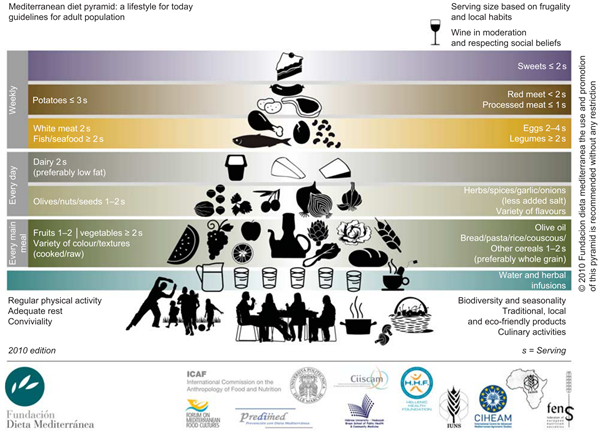
If you were asked to name a healthy eating diet, chances are you will select for the Mediterranean Diet. Frequently promoted in magazines and by health professionals, do we really understand what is meant it the Mediterranean Diet beyond Greek Salad, roasted vegetables and tomato-based sauces? In addition, there is a perception that the Mediterranean Diet is all about summer holidays and not cold rainy Britain in the winter. In this article, I will explore how the Mediterranean Diet has become to be the most cited healthy eating pattern and why. In addition, I will examine the eating pattern itself so that we can understand how it operates in practice so that we know how to adopt healthier eating choices ourselves.
The Mediterranean Diet has evolved over centuries following the ebb and flow of different civilisations that each introduced new foods into the local cuisine. For example, the Greek and Roman empires traded with Arabic, Egyptian and Turkish territories reinforcing the roles of legumes, cereals, nuts and fruits and introduced spices; and more latterly, the Spanish and Italian trade with the Americas brought in tomatoes, potatoes and more legumes. However, despite these influences, the Mediterranean Diet is traditionally frugal, mainly vegetable/fruit/cereal based and relatively high fat! The Mediterranean Diet was recognised by UNESCO as an Intangible Cultural Heritage of Humanity in 2011, confirming that the eating pattern is just one facet of a lifestyle that also incorporates social eating, cooking techniques, portion sizes and so forth.
The Mediterranean Dietary eating pattern was identified by Ancel Keys during the Seven Countries study. This study compared eating patterns and their effect on health in different regions of the world with a focus on cardiovascular disease risk and longevity. Today, a quick search in the PubMed database finds >2000 articles with the Mediterranean Diet in the title alone. It is one of the most studied eating patterns and this research has identified a range of beneficial effects of following this eating pattern. A review in 2018 (1) examined the association between Mediterranean Diet adherence and 37 different health outcomes. Through a meta-analysis of the data, they concluded that there is robust evidence for the positive effect of the Mediterranean Diet on overall mortality, cardiovascular diseases, overall cancer incidence, neurodegenerative diseases and diabetes. Each of these conditions has a major impact on our health service in addition to the effect they have on our personal and family lives. The study authors recognised that other health outcomes could potentially benefit from Mediterranean Diet adherence but at the moment, the evidence is limited due to a wide range of study methods and assessment techniques making comparisons more difficult. The exact mechanics of the health effect is not fully understood, and current research is investigating how the components affect our microbiome and the cellular responses in the body. However, it is likely that it is the effect of the combined dietary and lifestyle elements rather than individual components that deliver the health benefits. So, what do we mean by the Mediterranean Diet?

One way of visualising the Mediterranean Diet is to use a diet pyramid, as shown. This is taken from an article describing the eating and lifestyle pattern in full (2). It looks a bit daunting at first so I’ve translated it into a table that you can use to help you adjust your eating habits over time. I’ve included typical serving sizes to help your understanding of how much each recommendation means. Ultimately, there’s a focus on vegetables/fruit supported with wholegrains and legumes with a moderate amount of animal protein each week. There’s encouragement to save sweets/cakes as treats no more than twice/week and to cook from fresh ingredients using plenty of herbs and spices with olive oil as the main dietary fat.
Sounds easy enough, but more challenging in our fast-paced convenience-food driven world. However, increasing your vegetable/fruit intake towards that recommended or reducing the frequency of red meat or including a daily handful of nuts/seeds as suggested will increase your Mediterranean Diet adherence. You don’t have to change everything at once (unless you choose to), take a stepwise approach, one food group at a time and do it consistently to improve your daily eating habits. Research has shown that making a 2-point increase in adherence scores significantly reduces the risk of chronic conditions/mortality (3), so if you are looking to improve your health outcomes in the long-term, perhaps closer adherence to the Mediterranean Diet is a good place to start. If you need any help in achieving this, I am happy to help/guide you as the Mediterranean Diet was at the core of my MSc dissertation into nutrition knowledge and use of this eating pattern.
| Frequency | Food Type | No. Servings | Examples / Comments |
| Every main meal | Vegetables | ≥2 | Eat a wide variety, ideally one serving should be raw. 1 serving=2tbsp |
| Every main meal | Fruit | 1-2 | Eat a wide variety, make fruit the dessert of choice. 1 serving =80g berries, 1 apple/orange, 2 kiwi etc. |
| Every main meal | Cereals | 1-2 | Wholegrain choices of bread, pasta, couscous, rice and other cereals 1 serving =2 slices bread, 75g uncooked pasta/rice |
| Every main meal | Olive oil | 1-2 | Cooking fat of choice, serve with vegetables/salads. 1 serving =1tbsp |
| Every Day | Dairy | 2 | Low fat choices of cheese, fermented yogurt, milk. 1 serving =40g cheese, 100g yogurt, 225ml milk |
| Every Day | Nuts/ seeds/ olives | 1-2 | Source of healthy fats, proteins, vitamins and minerals. 1 serving= handful |
| Every Day | Herbs/spices /garlic/onions | Use widely for flavouring foods and to reduce salt usage | |
| Every Day | Water | 1.5-2L water/fluid daily, including herbal teas, low salt/low fat broths, avoid fizzy drinks/soda | |
| Weekly | Legumes | ≥2 | Wide range of beans/lentils with cereals as alternative to animal protein, 1 serving = 80g cooked |
| Weekly | Potatoes | ≤3 | Use fresh. 1 serving =2 tbsp cooked |
| Weekly | Eggs | 2-4 | 1 serving =2 medium-sized eggs |
| Weekly | Fish | ≥2 | 1 serving =100g cooked (palm-sized piece) |
| Weekly | White meat | 2 | 1 serving =100g cooked (palm-sized piece_ |
| Weekly | Red meat | <2 | 1 serving =100g cooked (palm-sized piece) |
| Weekly | Processed Meat | ≤1 | Includes bacon, sausage, salami. 1 serving =2 rashers or sausages |
| Weekly | Sweets/ pastries | ≤2 | Includes sweets, candies, cakes, biscuits, sweet and savoury pastry goods and ultra-processed foods such as ready meals |
| Wine | 1 small glass (100ml) per day preferably red wine, depending on cultural, religious practices and health status |
References
1. Dinu M, Pagliai G, Casini A, Sofi F. Mediterranean diet and multiple health outcomes: An umbrella review of meta-analyses of observational studies and randomised trials. Eur J Clin Nutr. 2018;72(1):30–43.
2. Bach-Faig A, Berry EM, Lairon D, Reguant J, Trichopoulou A, Dernini S, et al. Mediterranean diet pyramid today. Science and cultural updates. Public Health Nutr. 2011;14(12A):2274–84.
3. Lăcătușu CM, Grigorescu ED, Floria M, Onofriescu A, Mihai BM. The mediterranean diet: From an environment-driven food culture to an emerging medical prescription. Int J Environ Res Public Health [Internet]. 2019 [cited 2019 Aug 3];16(942):1–16. Available from: http://www.mdpi.com/10.3390/ijerph16060942
